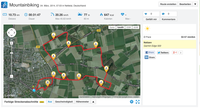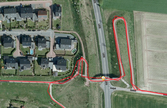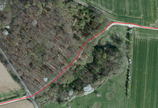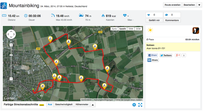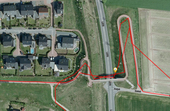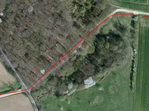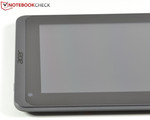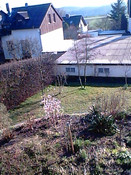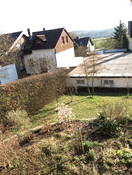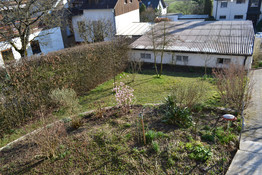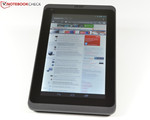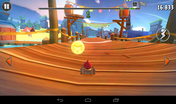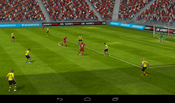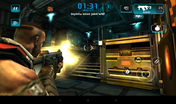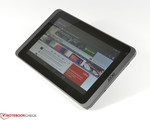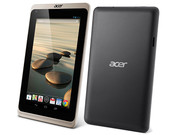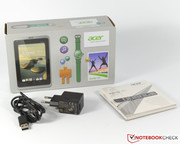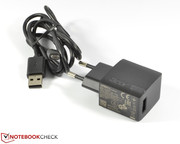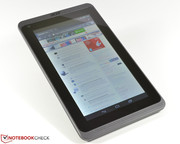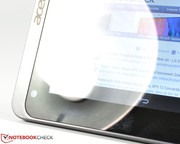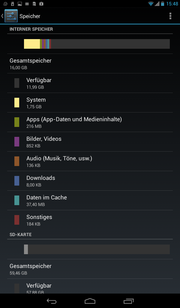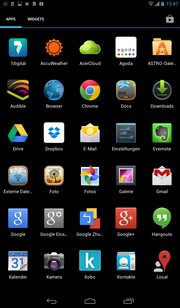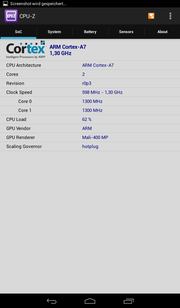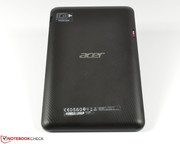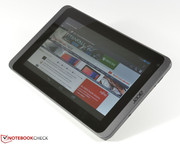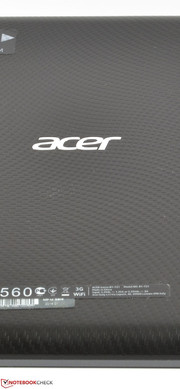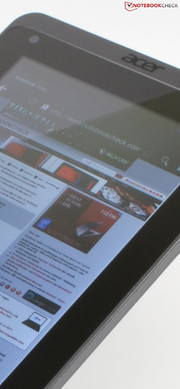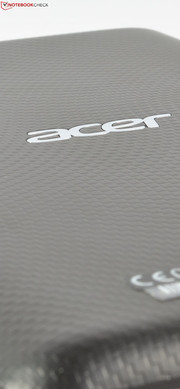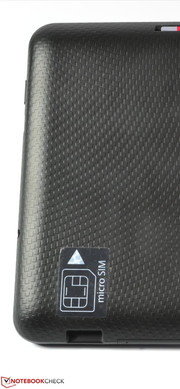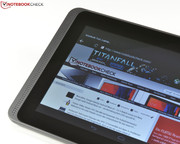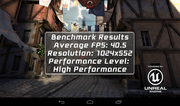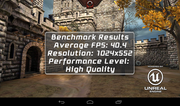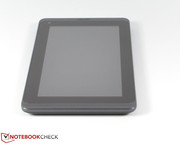Review Acer Iconia B1-721 Tablet
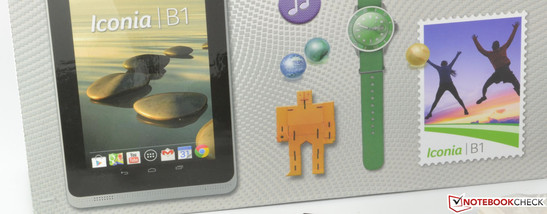
For the original German review, see here.
The Iconia B1-721 is Acer's new update to their budget series, now in its third generation. The manufacturer mixes some good ingredients into their interesting 7-inch device. The B1-720, a sibling of our review device, is available for just 129 Euros (~$180). Our B1-721 with 3G/UMTS sells for 179 Euros (~$250) and can be purchased in Smoky Gray or Vermilion Red.
Acer equips their B1-721 with a MediaTek MT8312 dual-core SoC with a clock frequency of 1.3 GHz and 1 GB of working memory. The 16 GB of internal memory can be expanded by up to 64 GB via microSD card. An LCD display with a resolution of 1024x600 pixels and a 7-inch diagonal competes for potential buyers' attention.
With these features, the Acer Iconia B1-721 tablet has to contend with the other members of its price class, namely the Asus Memo Pad HD 7, the Gigaset QV830, the Samsung Galaxy Tab 3 7.0 SM-T210, the HP Slate 7 Plus 4200ef, and the somewhat more expensive Google Nexus 7 2013.
Case
Visually, the Acer Iconia B1-721's gray case is appealing, and thanks to its ribbed backside, it feels good in your hands as well. However, constructed entirely of polycarbonate, the tablet's stability and resistance to twisting are less winsome. Even under just moderate pressure, the case makes an audible creaking noise and the display colors temporarily distort. This is especially true of the top third of the device, near the connections. But overall we are pleased with the manufacturing quality, as the gaps where the pieces of the case come together are completely even. All things considered, for this price class, the tablet's manufacturing quality is satisfactory.
At a height and width of 199 x 122 mm (7.8 x 4.8 inches), a thickness of about 11 mm (~0.4 inches) and a weight of 317 grams (~0.7 pounds), the Acer tablet is more or less on par with the rest of the competition. Unfortunately, it is also standard for this price class that the 2955 mAh and 11.2 Wh battery cannot be switched out. However, it would be possible to extend the device's runtime with the help of an external spare battery.
Connectivity
Acer outfits their Iconia B1-721 with a MediaTek MT8312 dual-core SoC with a clock frequency of 1.3 GHz alongside an integrated Mali MP400 graphics card and 1 GB of RAM. The 16 GB of internal flash memory can be expanded by up to 64 GB using a microSD card.
The B1-721 is also equipped with a SIM card slot for 3G functionality, a micro USB 2.0 port and a 3.5 mm audio jack. The power button and the volume rocker work flawlessly and have a palpable click point.
Software
Android version 4.2.2 Jelly Bean acts as the tablet's operating system. Acer has done nothing to interfere with the OS -- it is Android's stock interface.
Some useful software like AccuWeather, Audible and AcerCloud come preinstalled. We were pleased to see that Acer also kept the bloatware within reasonable limits.
Communication & GPS
Along with WLAN 802.11 b/g/n, Acer integrates a SIM card slot with a UMTS/3G module in their B1-721. That means mobile surfing should be possible almost anywhere. In our test, the tablet held a stable connection to the network 10 meters from the router and through several massive walls. We did not experience any interruptions in the connection.
Our test device also has a GPS module, which even indoors found a relatively good signal during our test with the app GPS Test. In our GPS comparison test with the Garmin Edge 500, the Acer Iconia B1-721 had mixed results. The tablet recorded our position during our short trip through the forest quite accurately, but it frequently positioned us a little off-course during the tricky bridge portion of our test. Curves are condensed into zigzags, which means the overall route logged by the Acer tablet differs somewhat from the Garmin device's route. The B1-721 is certainly well-equipped to be used for navigation purposes, as long as the user does not need the device to function with a high degree of precision.
Cameras & Multimedia
The Acer Iconia B1-721 comes with just a VGA webcam -- unfortunately there is no main camera at the rear. Pictures are accordingly poor quality, plagued with a high level of image noise and blurriness. These problems intensify exponentially in adverse lighting situations. The VGA videos suffer from the same malady. An image comparison would be superfluous due to the indisputably poor quality of the tablet's pictures, particularly as it only has a front camera. The camera is only worth using for the occasional video chat.
Directly compared to the Apple iPad Mini Retina, the enormous difference in image quality is immediately apparent -- let alone the SLR reference camera.
Accessories
The B1-721's packaging includes the tablet itself and a modular 10 Watt power supply. A variety of protective covers are also available at additional cost.
Warranty
Acer provides their Iconia B1-721 with a 12-month carry-in warranty.
Input Devices & Operation
The virtual keyboards correspond to the Android standard and function intuitively and reliably, as per usual. As is generally true of the Android keyboard, in portrait mode it only takes up about a third of the display, but the key size is still large enough to allow for error-free typing. In landscape mode, together with the Android navigation keys, the keyboard takes up about 50% of the screen. If you then subtract the browser's navigation bar, only a rather thin portion of the open website remains visible.
Overall, the capacitive 10-point multitouch screen registers inputs reliably and with a high degree of precision. When you rotate the display, the tablet has to think for a second before switching formats, but this is acceptable for its class.
Display
At 1024x600 pixels, the Acer Iconia B1-721's 7-inch display has a somewhat low resolution. Some of the competition offers substantially more here -- for instance the Google Nexus 7 2013 earns the right to flaunt its 1920x1200 pixels, and both the Asus Memo Pad HD 7 and the HP Slate 7 Plus 4200ef provide a significantly higher resolution of 1280x800 pixels. The Samsung Galaxy Tab 3 7.0 SM-T210 and the Gigaset QV830 are more or less on par with our test device (1024x768 and 1024x600 pixels respectively).
Still, the display content looks sharp, and at an average of 401.7 cd/m², it is very bright too. Compared to other devices in its class, the Acer Iconia B1-721 does well here. It glows considerably brighter than the Gigaset QV830 (271 cd/m²) and leaves the Asus Memo Pad HD 7 (332.1 cd/m²) in the dust as well. At 426.6 cd/m², the Samsung Galaxy Tab 3 7.0 SM-T210 does not glow substantially brighter. But our test device cannot keep up with the Google Nexus 7 2013, which at 513.4 cd/m² is clearly the best in its class.
| |||||||||||||||||||||||||
Brightness Distribution: 75 %
Center on Battery: 423 cd/m²
Contrast: 415:1 (Black: 1.02 cd/m²)
ΔE ColorChecker Calman: 13.35 | ∀{0.5-29.43 Ø4.78}
ΔE Greyscale Calman: 14.62 | ∀{0.09-98 Ø5}
Gamma: 2.17
CCT: 22140 K
The LCD display's greatest weakness is its uneven brightness distribution -- its brightness levels are only 75% similar across the screen, and it has some heavy clouding to boot. The latter is noticeable in monochromatic areas and dark images, and subjectively it makes the contrast appear weaker. The high black value of 1.02 cd/m² paired with the screen's high brightness level result in a contrast ratio of only 415:1. But in everyday use, subjectively the display is still satisfactory.
The measurements we took with CalMAN reveal substantial deviations from the norm, particularly in the areas of red and blue. The high average DeltaE of 13.35 underlines this shortcoming. The grayscale shows an extreme blue cast as well. In practical use, however, these deficits are not terribly obvious and are only manifested blatantly in monochromatic images.
Thanks to its high maximum brightness level of 444 cd/m², on principle the Acer Iconia B1-721 is well-suited for outdoor use, even if use under direct sunlight is rendered difficult by the highly reflective display. In at least partially shaded areas, the tablet is fully useable.
Performance
The ARM Cortex A7-based dual-core SoC at work in the Acer Iconia B1-721 has a clock frequency of 1.3 GHz, is produced by MediaTek and goes by the name MT8312. For a tablet in the entry-level class of up to 200 Euros (~$275), this SoC is a good choice. In terms of performance, it is more or less on par with the competition -- at least on paper.
But our comparisons in several synthetic benchmarks leave a mixed impression. Our review device scores well in the Geekbench 3 single-core test, beating both the Gigaset QV830 and the HP Slate 7 Plus 4200ef by a small margin, but in the multi-core test the results are flipped. In Smartbench 2012 and Linpack for Android, the Iconia B1-721 falls behind almost every other competing device. Speaking of falling behind, in the 3DMark Ice Storm test the competition computes up to 64% faster than our review device. The considerably stronger class leader, the Google Nexus 7 2013, shows up the Acer Iconia B1-721 with its up to 372% better performance. But to run the majority of a normal user's everyday applications, the Acer tablet's performance should be sufficient.
| Geekbench 3 | |
| 32 Bit Multi-Core Score (sort by value) | |
| Acer Iconia B1-721 | |
| Gigaset QV830 | |
| HP Slate 7 Plus 4200ef | |
| Asus Memo Pad HD 7 | |
| 32 Bit Single-Core Score (sort by value) | |
| Acer Iconia B1-721 | |
| Gigaset QV830 | |
| HP Slate 7 Plus 4200ef | |
| Asus Memo Pad HD 7 | |
| Linpack Android / IOS - Multi Thread (sort by value) | |
| Acer Iconia B1-721 | |
| Google Nexus 7 2013 | |
| Gigaset QV830 | |
| HP Slate 7 Plus 4200ef | |
| Asus Memo Pad HD 7 | |
| Asus Memo Pad HD 7 | |
| Smartbench 2012 - Productivity Index (sort by value) | |
| Acer Iconia B1-721 | |
| Google Nexus 7 2013 | |
| Gigaset QV830 | |
| HP Slate 7 Plus 4200ef | |
| Asus Memo Pad HD 7 | |
| AnTuTu v4 - Total Score (sort by value) | |
| Acer Iconia B1-721 | |
| Gigaset QV830 | |
| HP Slate 7 Plus 4200ef | |
| GFXBench (DX / GLBenchmark) 2.7 | |
| T-Rex Onscreen (sort by value) | |
| Acer Iconia B1-721 | |
| Google Nexus 7 2013 | |
| Gigaset QV830 | |
| HP Slate 7 Plus 4200ef | |
| Asus Memo Pad HD 7 | |
| 1920x1080 T-Rex Offscreen (sort by value) | |
| Acer Iconia B1-721 | |
| Google Nexus 7 2013 | |
| Gigaset QV830 | |
| HP Slate 7 Plus 4200ef | |
| Asus Memo Pad HD 7 | |
| 3DMark | |
| 1280x720 Ice Storm Standard Score (sort by value) | |
| Acer Iconia B1-721 | |
| Google Nexus 7 2013 | |
| Gigaset QV830 | |
| HP Slate 7 Plus 4200ef | |
| Asus Memo Pad HD 7 | |
| 1280x720 Ice Storm Standard Graphics (sort by value) | |
| Acer Iconia B1-721 | |
| Google Nexus 7 2013 | |
| Gigaset QV830 | |
| HP Slate 7 Plus 4200ef | |
| Asus Memo Pad HD 7 | |
| 1280x720 Ice Storm Standard Physics (sort by value) | |
| Acer Iconia B1-721 | |
| Google Nexus 7 2013 | |
| Gigaset QV830 | |
| HP Slate 7 Plus 4200ef | |
| Asus Memo Pad HD 7 | |
If you look at the browser-based benchmark tests, compared to the rest of the tablets in its class, the Acer Iconia B1-721's performance proves to be more or less average here too. In SunSpider 1.0, for instance, on average our test device comes in about 20% behind the Asus Memo Pad HD 7 and the others. The Samsung Galaxy Tab 3 7.0 SM-T210 is the only device that has to admit clear defeat in both the SunSpider and the Peacekeeper benchmarks. In the latter and in Browsermark 2, our test device outpaces almost all the competition and draws very near to the Google Nexus 7 2013.
In everyday use, however, these mixed results are not all that noticeable. Web pages load quickly, and surfing goes even faster with a browser like Google Chrome.
| Google V8 Ver. 7 - Google V8 Ver. 7 Score (sort by value) | |
| Acer Iconia B1-721 | |
| Google Nexus 7 2013 | |
| Gigaset QV830 | |
| HP Slate 7 Plus 4200ef | |
| Asus Memo Pad HD 7 | |
| Samsung Galaxy Tab 3 7.0 inch | |
| Octane V2 - Total Score (sort by value) | |
| Acer Iconia B1-721 | |
| HP Slate 7 Plus 4200ef | |
| Asus Memo Pad HD 7 | |
| Mozilla Kraken 1.1 - Total (sort by value) | |
| Acer Iconia B1-721 | |
| Gigaset QV830 | |
| HP Slate 7 Plus 4200ef | |
| Asus Memo Pad HD 7 | |
| Sunspider - 1.0 Total Score (sort by value) | |
| Acer Iconia B1-721 | |
| Google Nexus 7 2013 | |
| Gigaset QV830 | |
| HP Slate 7 Plus 4200ef | |
| Asus Memo Pad HD 7 | |
| Samsung Galaxy Tab 3 7.0 inch | |
| Peacekeeper - --- (sort by value) | |
| Acer Iconia B1-721 | |
| Google Nexus 7 2013 | |
| Gigaset QV830 | |
| HP Slate 7 Plus 4200ef | |
| Asus Memo Pad HD 7 | |
| Samsung Galaxy Tab 3 7.0 inch | |
| WebXPRT 2013 - Overall (sort by value) | |
| Acer Iconia B1-721 | |
| Gigaset QV830 | |
| HP Slate 7 Plus 4200ef | |
| Asus Memo Pad HD 7 | |
| Browsermark - --- (sort by value) | |
| Acer Iconia B1-721 | |
| Google Nexus 7 2013 | |
| Gigaset QV830 | |
| HP Slate 7 Plus 4200ef | |
| Asus Memo Pad HD 7 | |
* ... smaller is better
Games
As expected, the Mali MP400 graphics solution integrated into the SoC does not merit a standing ovation, but it is powerful enough for a current 3D game here or there. We did not experience any problems running the games FIFA 14, Shadowgun: Deadzone or Angry Birds Go! in our test.
In terms of controls, the touchscreen, the position sensor and the accelerometer all function very well and consistently allow the user to precisely control what is happening on the screen.
Emissions
Temperature
The surface temperatures we measured on the tablet's case during practical, everyday use give us no cause for concern. In idle mode, the average temperatures came to around 27 °C (80.6 °F) on the underside of the tablet and 30.6 °C (87.08 °F) on the top side.
After a long period under full load, these temperatures rise to 32.4 to 33.4 °C (90.32 to 92.12 °F). The tablet reached its maximum temperatures in the area of the SoC -- 40 °C (104 °F) on the underside and 41.6 °C (106.88 °F) on the top side. The Acer Iconia B1-721 never grew uncomfortably hot. The little power supply, however, heated up to a maximum of 45.6 °C (114.08 °F), so it should always be left out in the open.
(±) The maximum temperature on the upper side is 41.6 °C / 107 F, compared to the average of 33.7 °C / 93 F, ranging from 20.7 to 53.2 °C for the class Tablet.
(±) The bottom heats up to a maximum of 40 °C / 104 F, compared to the average of 33.2 °C / 92 F
(+) In idle usage, the average temperature for the upper side is 30.6 °C / 87 F, compared to the device average of 30 °C / 86 F.
Speaker
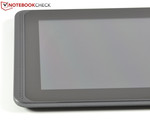
At higher volumes, the mono speaker built into the front of the tablet has trouble producing undistorted and noise-free sound. Voices and music sound thin and are lacking in mid-tones and bass. But compared to the rest of the devices in its class, the B1-721's sound is more or less standard. The Acer Iconia B1-721 cannot hold a candle to the Apple iPad Mini Retina here. The 3.5 mm jack, however, outputs sound flawlessly and at maximum volume (on a good set of headphones).
Battery Life
The Acer Iconia B1-721 is equipped with an 11.2 Wh battery with a capacity of 2955 mAh. Combined with the tablet's relatively frugal SoC, it is able to provide the device with entirely respectable battery runtimes -- though it comes nowhere close to holding out through a whole work day in constant use. Compared to the competition, the tablet's battery life is not stellar, as it is outfitted with a considerably weaker battery.
The B1-721 runs for a maximum of 9 hours and 11 minutes without an external power source. Here the Google Nexus 7 2013 laps our test device several times over and holds out for over 44 hours with its fat 3950 mAh/16 Wh battery. But the Asus Memo Pad HD 7 (3950 mAh/16Wh) with a maximum runtime of about 17 hours, the HP Slate 7 Plus 4200ef (14 Wh) with about 15.5 hours and the Gigaset QV830 (3260 mAh) with about 21 hours all last considerably longer than the B1-721 too.
In our WLAN surf test, which is meant to simulate everyday use, with the brightness set to about 30% (150 cd/m²), our test device chugs along for 4 hours and 17 minutes. Here too, the competition all runs at least 1.5 hours longer. A user who is frequently out and about and needs to use the Internet all day should be sure to bring along the compact charger or an external spare battery.
Under load with the Stability Test app, at the highest brightness setting and with activated communication modules, our test device cuts out after just 1.5 hours. The B1-721's competitors all offer at least double the runtime here.
Verdict
So, is the Acer Iconia B1-721 a price-performance gem? In short: Not really. True, its application performance is acceptable, and the communication modules perform flawlessly as well. UMTS 3G is on board alongside Bluetooth 4.0 and a relatively spacious 16 GB of internal memory. With its high maximum brightness level, the tablet is well-suited for outdoor use.
But the tablet has several disadvantages to be weighed alongside the good. Its display has a low resolution and is plagued with heavy clouding and poor color reproduction. The webcam's quality is simply miserable, and the mono speaker produces a mediocre sound. Unfortunately, the device's battery life is also disappointing -- it cannot make it through an entire workday in constant use without reconnecting to the power supply. Also, its case can be twisted rather easily.
If you can live with those drawbacks and want as much “bang for your buck” as possible, at a current recommended retail price of 179 Euros (~$250), the Acer Iconia B1-721 represents a solid average-quality tablet that offers a lot of good features -- but comes with its weaknesses too. Some of the competition in this price range is very strong, so a closer look at how the available tablets compare is worth the effort.











